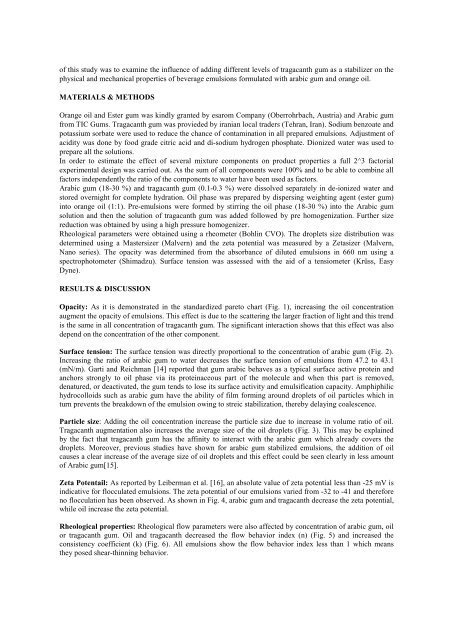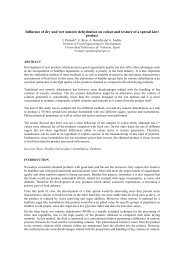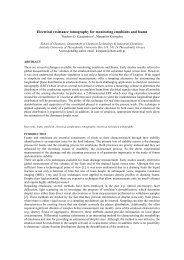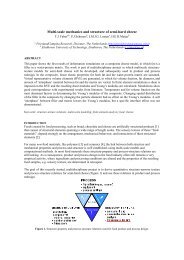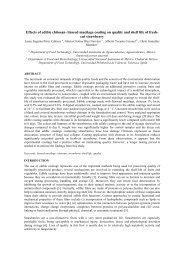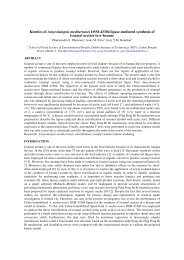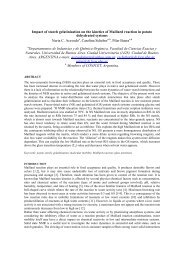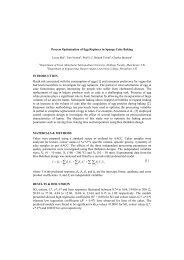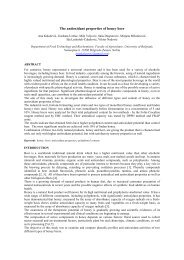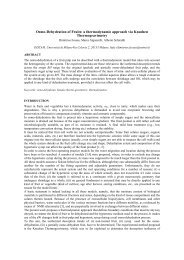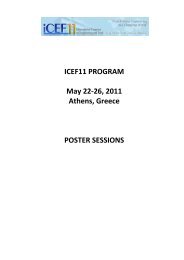Physical Stability of Beverage Emulsions as Influences - 11th ...
Physical Stability of Beverage Emulsions as Influences - 11th ...
Physical Stability of Beverage Emulsions as Influences - 11th ...
Create successful ePaper yourself
Turn your PDF publications into a flip-book with our unique Google optimized e-Paper software.
<strong>of</strong> this study w<strong>as</strong> to examine the influence <strong>of</strong> adding different levels <strong>of</strong> tragacanth gum <strong>as</strong> a stabilizer on the<br />
physical and mechanical properties <strong>of</strong> beverage emulsions formulated with arabic gum and orange oil.<br />
MATERIALS & METHODS<br />
Orange oil and Ester gum w<strong>as</strong> kindly granted by esarom Company (Oberrohrbach, Austria) and Arabic gum<br />
from TIC Gums. Tragacanth gum w<strong>as</strong> provieded by iranian local traders (Tehran, Iran). Sodium benzoate and<br />
pot<strong>as</strong>sium sorbate were used to reduce the chance <strong>of</strong> contamination in all prepared emulsions. Adjustment <strong>of</strong><br />
acidity w<strong>as</strong> done by food grade citric acid and di-sodium hydrogen phosphate. Dionized water w<strong>as</strong> used to<br />
prepare all the solutions.<br />
In order to estimate the effect <strong>of</strong> several mixture components on product properties a full 2^3 factorial<br />
experimental design w<strong>as</strong> carried out. As the sum <strong>of</strong> all components were 100% and to be able to combine all<br />
factors independently the ratio <strong>of</strong> the components to water have been used <strong>as</strong> factors.<br />
Arabic gum (18-30 %) and tragacanth gum (0.1-0.3 %) were dissolved separately in de-ionized water and<br />
stored overnight for complete hydration. Oil ph<strong>as</strong>e w<strong>as</strong> prepared by dispersing weighting agent (ester gum)<br />
into orange oil (1:1). Pre-emulsions were formed by stirring the oil ph<strong>as</strong>e (18-30 %) into the Arabic gum<br />
solution and then the solution <strong>of</strong> tragacanth gum w<strong>as</strong> added followed by pre homogenization. Further size<br />
reduction w<strong>as</strong> obtained by using a high pressure homogenizer.<br />
Rheological parameters were obtained using a rheometer (Bohlin CVO). The droplets size distribution w<strong>as</strong><br />
determined using a M<strong>as</strong>tersizer (Malvern) and the zeta potential w<strong>as</strong> me<strong>as</strong>ured by a Zet<strong>as</strong>izer (Malvern,<br />
Nano series). The opacity w<strong>as</strong> determined from the absorbance <strong>of</strong> diluted emulsions in 660 nm using a<br />
spectrophotometer (Shimadzu). Surface tension w<strong>as</strong> <strong>as</strong>sessed with the aid <strong>of</strong> a tensiometer (Krüss, E<strong>as</strong>y<br />
Dyne).<br />
RESULTS & DISCUSSION<br />
Opacity: As it is demonstrated in the standardized pareto chart (Fig. 1), incre<strong>as</strong>ing the oil concentration<br />
augment the opacity <strong>of</strong> emulsions. This effect is due to the scattering the larger fraction <strong>of</strong> light and this trend<br />
is the same in all concentration <strong>of</strong> tragacanth gum. The significant interaction shows that this effect w<strong>as</strong> also<br />
depend on the concentration <strong>of</strong> the other component.<br />
Surface tension: The surface tension w<strong>as</strong> directly proportional to the concentration <strong>of</strong> arabic gum (Fig. 2).<br />
Incre<strong>as</strong>ing the ratio <strong>of</strong> arabic gum to water decre<strong>as</strong>es the surface tension <strong>of</strong> emulsions from 47.2 to 43.1<br />
(mN/m). Garti and Reichman [14] reported that gum arabic behaves <strong>as</strong> a typical surface active protein and<br />
anchors strongly to oil ph<strong>as</strong>e via its proteinaceous part <strong>of</strong> the molecule and when this part is removed,<br />
denatured, or deactivated, the gum tends to lose its surface activity and emulsification capacity. Amphiphilic<br />
hydrocolloids such <strong>as</strong> arabic gum have the ability <strong>of</strong> film forming around droplets <strong>of</strong> oil particles which in<br />
turn prevents the breakdown <strong>of</strong> the emulsion owing to streic stabilization, thereby delaying coalescence.<br />
Particle size: Adding the oil concentration incre<strong>as</strong>e the particle size due to incre<strong>as</strong>e in volume ratio <strong>of</strong> oil.<br />
Tragacanth augmentation also incre<strong>as</strong>es the average size <strong>of</strong> the oil droplets (Fig. 3). This may be explained<br />
by the fact that tragacanth gum h<strong>as</strong> the affinity to interact with the arabic gum which already covers the<br />
droplets. Moreover, previous studies have shown for arabic gum stabilized emulsions, the addition <strong>of</strong> oil<br />
causes a clear incre<strong>as</strong>e <strong>of</strong> the average size <strong>of</strong> oil droplets and this effect could be seen clearly in less amount<br />
<strong>of</strong> Arabic gum[15].<br />
Zeta Potentail: As reported by Leiberman et al. [16], an absolute value <strong>of</strong> zeta potential less than -25 mV is<br />
indicative for flocculated emulsions. The zeta potential <strong>of</strong> our emulsions varied from -32 to -41 and therefore<br />
no flocculation h<strong>as</strong> been observed. As shown in Fig. 4, arabic gum and tragacanth decre<strong>as</strong>e the zeta potential,<br />
while oil incre<strong>as</strong>e the zeta potential.<br />
Rheological properties: Rheological flow parameters were also affected by concentration <strong>of</strong> arabic gum, oil<br />
or tragacanth gum. Oil and tragacanth decre<strong>as</strong>ed the flow behavior index (n) (Fig. 5) and incre<strong>as</strong>ed the<br />
consistency coefficient (k) (Fig. 6). All emulsions show the flow behavior index less than 1 which means<br />
they posed shear-thinning behavior.


